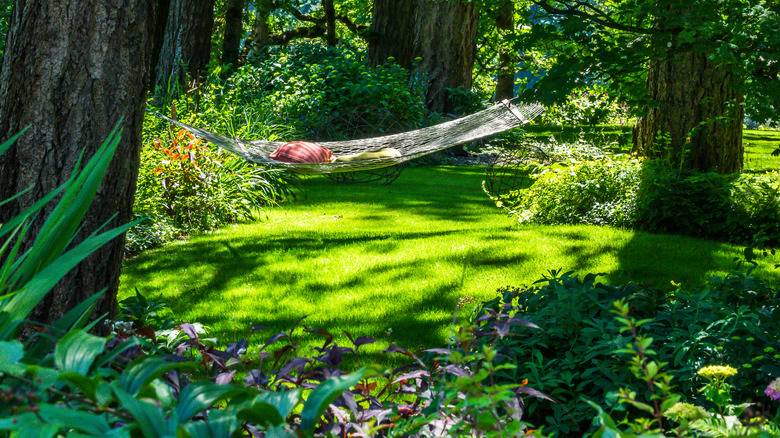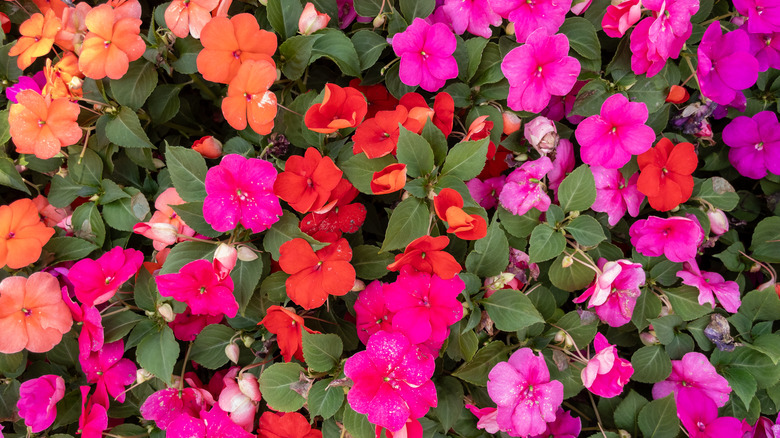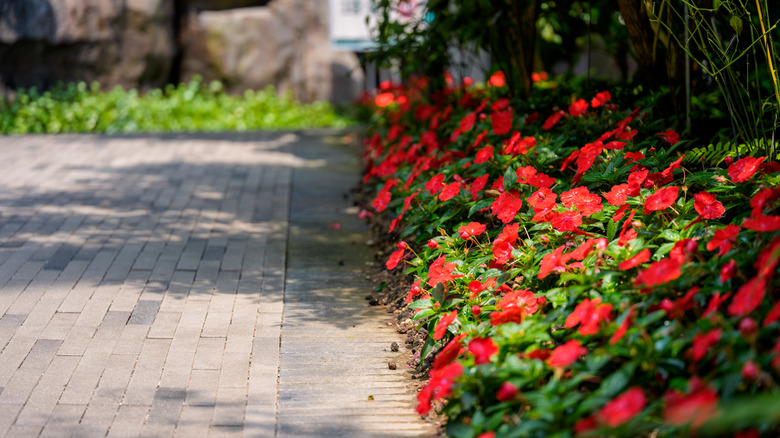Here's One Of The Few Flowers That Bloom All Year—Perfect For Warm, Shady Gardens
If you are gardening in a location where it never gets cold enough for frost to occur, you'll want a flower that provides continuous color, even in shaded areas. If you're lucky enough to live in a frost-free area, like in USDA Hardiness Zones 10 or 11, you know the struggle of finding flowers that will provide continuous color in the shade all year long. The plant that's perfect for warm, shady gardens is impatiens (Impatiens walleriana). When grown in warm conditions, it grows as an herbaceous perennial that can blanket shady garden beds and containers with flowers every day of the year. When most other flowers are taking a break, impatiens just keep blooming.
Its native range is East Africa, specifically in Mozambique, Tanzania, and Zimbabwe, which is why it loves to grow where it's consistently warm and humid. The flowers are showy, coming in a rainbow of shades including pink, rose, red, lilac, purple, orange, white, and bicolors. They grow in a bushy, mounding shape, and the leaves range in color from light to dark green. If you're looking to plant under a large tree or around a porch that never gets sun, this plant will thrive without direct sunlight and be your year-round friend.
Getting the conditions right for big blooms
Making sure your impatiens grow and bloom year round comes down to reproducing the environment of its native East Africa. This fast-growing flower that loves the shade is exceptionally thirsty, needing consistently damp soil to prevent its stems from wilting. If you see the plant suddenly flop over, it's a sign it needs a good drink, though they bounce back quickly after watering. Water them regularly, especially during hotter, dry periods, but keep in mind that the soil needs to drain well. Placing them in a spot with high-quality, well-draining soil mixed with plenty of organic compost will help the roots get the moisture they need.
The old-fashioned varieties do their best in light to full shade, where they are protected from the harsh afternoon sun. Too much direct light will scorch the leaves and cause the plants to not bloom as often. Morning sun is fine, but they absolutely need protection when the sun is at its strongest in the middle of the day. For those with sunny areas that love the look of impatiens, the New Guinea hybrids do well in partly sunny gardens and SunPatiens are perfect for bright, full-sun spots. If these flowers are planted in containers or hanging baskets, remember that these often dry out faster than garden beds, so checking the soil often is a must to make sure it's damp enough.
Keeping your impatiens looking great
The great news about planting impatiens in your shady garden is that they're generally considered low maintenance once they're in the ground and happily settled. They are known as "self-cleaning" flowers, which means the spent blooms naturally drop off on their own, sparing you the time and effort of deadheading. To keep their bushy, rounded shape and prevent them from getting too long and leggy later in the season, pinch back the top ⅓ of growth to keep them blooming.
One issue that affects impatiens to keep in mind is downy mildew. To know what downy mildew looks like, watch for leaves that are turning yellow and curling under, and check the underside for white, fuzzy growth. There's no cure for a plant that is infected with downy mildew, so you need to immediately remove and bag the entire plant, including its roots, and throw it in the trash (and not the compost). To stop the disease from taking hold, water the soil instead of using an overhead sprinkler and make sure the plants are spaced far enough apart for air circulation.
There are newer, disease-resistant varieties, such as the "Beacon" and "Imara," which allow gardeners to enjoy the classic look of impatiens without the worry. Regardless of what variety you plant, feed your impatiens with a balanced, water-soluble fertilizer every few weeks or apply a slow-release product at planting time for the best flower production throughout the year. Giving them a consistent food source is an important part of their nonstop flowering habit.


